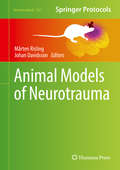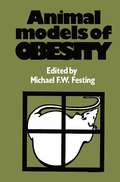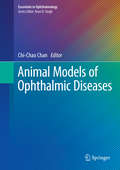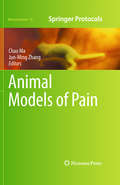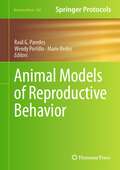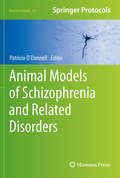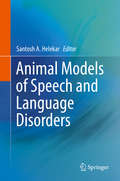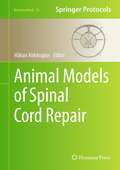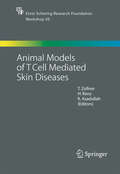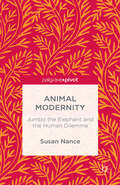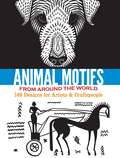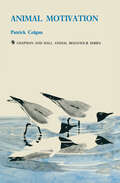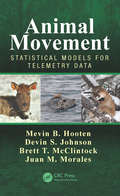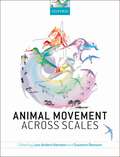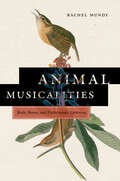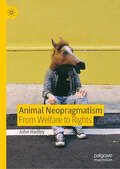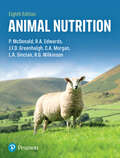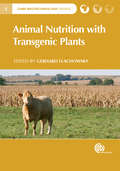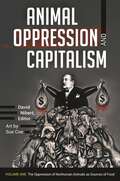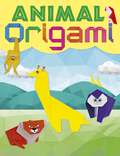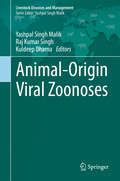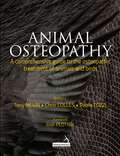- Table View
- List View
Animal Models of Neurotrauma (Neuromethods #149)
by Mårten Risling Johan DavidssonThis volume looks into the need for a variety of experimental models for research on traumatic brain injury (TBI) and peripheral nervous system. It also describes a number of experimental models, such as mechanical devices, that have been developed to model neurotrauma in animal experiments. The overall aim of this book is to explore the variety of models and how they are used in current research. The chapters in this book are organized in four sections and talk about animal models for TBI; animal models for spinal cord or nerve injury; and translational aspects, secondary injuries, in vitro studies, and evaluation of large data sets. In Neuromethods series style, chapters include the kind of detail and key advice from the specialists needed to get successful results in your laboratory.Cutting-edge and comprehensive, Animal Models of Neurotrauma is a valuable resource for researchers interested in expanding their knowledge and research in this developing field.
Animal Models of Ophthalmic Diseases (Essentials in Ophthalmology)
by Chi-Chao ChanThis book describes experimental animal models that mimic common human ocular diseases: herpetic keratitis, cataract, glaucoma, age-related macular degeneration, diabetic retinopathy, uveitis, retinitis pigmentosa, Graves’ disease, and intraocular tumors. In conjunction, these models reflect the diversity and utility of tools used to study human disease. World expert clinicians discuss each model based on their clinical experience and the text is supported by numerous photos and diagrams. In describing the most pertinent animal models of ophthalmic diseases, this book will be of interest to ophthalmologists, vision researchers, fellows, residents and medical students.
Animal Models of Pain (Neuromethods #49)
by Chao Ma and Jun-Ming ZhangWith the loss of work days, the price of health care and payments for compensation, litigation, and malpractice, and the overwhelming cost of human suffering, chronic pain syndromes affect humanity enormously on both an economic and personal level. In Animal Models of Pain, expert investigators in the field provide a consolidated review of the current state of pain research by capturing the diversity of animal models that are used to investigate pain mechanisms, which range from surgical incision to mechanical compression and from spinal cord injury to cutaneous/local inflammation and beyond. As a volume in the respected Neuromethods series, this book delivers its vital content through detailed descriptions of a wide variety of step-by-step laboratory methods. Authoritative and cutting-edge, Animal Models of Pain seeks to lead scientists closer to the ultimate goal of improving the quality of life and relieving the unbearable burden of chronic pain for millions of people throughout the world.
Animal Models of Reproductive Behavior (Neuromethods #200)
by Raúl G. Paredes Wendy Portillo Marie BedosThis volume presents the latest techniques to study several aspects of reproductive behavior in different species. The chapters in this book cover topics such as methods to investigate social behavior; sexual motivation and reward, both of which are fundamental for the initiation of sexual behavior; olfactory signaling; different characteristics and models of reproductive function; and parental behavior in both rats and rabbits. In the Neuromethods series style, chapters include the kind of detail and key advice from the specialists needed to get successful results in your laboratory. Cutting-edge and practical, Animal Models of Reproductive Behavior is a valuable resource for both experienced researchers and students who want to incorporate new techniques into their studies of reproductive behavior.
Animal Models of Schizophrenia and Related Disorders (Neuromethods #59)
by Patricio O'DonnellAnimal models of schizophrenia and other major psychiatric disorders have been sought for decades, and, as a result, we are now facing new vistas on pathophysiology that could lead to novel therapeutic approaches and even hint at possible preventive strategies. Animal Models of Schizophrenia and Related Disorders presents an overview of the information that can be obtained with several different models and a detailed account of how to generate such models in order to ensure that the manipulations used to model schizophrenia-relevant phenomena are used consistently across laboratories. This detailed volume features pharmacological models such as non-competing NMDA antagonists, emphasizing their use in vitro, neurodevelopmental models such as the neonatal ventral hippocampal lesion and the antimitotic MAM, models that reproduce environmental factors such as neonatal hypoxia, vitamin D deficits, and prenatal immune activation, as well as several different genetic model approaches. As a volume in the Neuromethods series, this volume contains the kind of detailed description and implementation advice that is crucial for getting optimal results.Practical and cutting-edge, Animal Models of Schizophrenia and Related Disorders highlights the successes in the use of animal models to gain insight on pathophysiological mechanisms of relevance to major psychiatric disorders in the hope of inspiring investigators to expand the research and test targets that could restore or ameliorate function.
Animal Models of Speech and Language Disorders
by Santosh A. HelekarBasic research over the last decade or two has uncovered similarities between speech, especially its sensori-motor aspects, and vocal communication in several non-human species. The most comprehensive studies so far have been conducted in songbirds. Songbirds offer us a model system to study the interactions between developmental or genetic predispositions and tutor-dependent influences, on the learning of vocal communication. Songbird research has elucidated cellular and molecular mechanisms underlying learning and production of vocal patterns, perception of vocal sounds, vocal motor control and vocal neuromotor plasticity. More recently, the entire genome of the songbird zebra finch has been sequenced. These discoveries, along with the identification of several genes implicated in familial human speech and language disorders, have made it possible to look for analogues of speech and language dysfunction in zebra finches, at least at the perceptual and sensori-motor levels. Two approaches in particular have led us closer to the development of animal models of human speech conditions, namely developmental stuttering and a familial verbal dyspraxia associated with a mutation in the gene for the transcription factor FoxP2. Work on other animals that show developmental sensori-motor learning of vocal sounds used for communication have also shown significant progress, leading to the possibility of development of models of speech and language dysfunction in them. Among mammals, the principal ones include dolphins and whales. In non-human primates, while vocal learning per se is not very prominent, investigations on their communicative abilities have thrown some light on the rudiments of language. These considerations make the publication of a book focused on animal models of speech and language disorders, detailing the overall investigative approach of neurobehavioral studies in animals capable of vocal communication and learned vocalizations, a much-needed and worthwhile project. It would serve as a unifying review of research in this new multidisciplinary frontier, spanning the molecular to the behavioral, for clinicians and researchers, as well as a teaching resource for advanced speech pathology and neuroscience students. This book will also be the first of its kind.
Animal Models of Spinal Cord Repair (Neuromethods #76)
by Håkan AldskogiusThe development of treatment strategies that can help patients with spinal cord injury to regain lost functions and an improved quality of life is a major medical challenge, and experimental spinal cord research has to meet these challenges by resolving fundamental problems, establishing a basis for possible novel treatment strategies of spinal cord injury, and motivating their clinical translation. In Animal Models of Spinal Cord Repair, expert researchers examine a broad range of experimental models for research on spinal cord injury, how they have contributed to our current state of knowledge, and what their advantages are in the further advancement of spinal cord repair. With models from simple lamprey to non-human primates, the information presented is intended to guide the implementation of animal models for spinal cord repair as well as to raise the awareness of the relevance of experimental models which may not be in the current mainstream of this research. As a part of the Neuromethods series, this work contains the kind of detailed description and implementation advice to guarantee successful results in the laboratory. Comprehensive and cutting-edge, Animal Models of Spinal Cord Repair presents the background information and hands-on methods descriptions, as well as the basic and clinical issues, needed to stimulate and guide researchers with different backgrounds towards the development of improved strategies for functionally relevant repair of the injured human spinal cord.
Animal Models of T Cell-Mediated Skin Diseases (Ernst Schering Foundation Symposium Proceedings #50)
by T. Zollner Harald Renz Khusru AsadullahPharmaceutical companies are spending increasing amounts of money on drug discovery and development. Nevertheless, attrition rates in clinical development are still very high, and up to 90% of new compounds fail in clinical phase I - III trials, which is partially due to lack of clinical efficacy. This indicates a strong need for highly predictive in vitro and in vivo models. The "50th International Workshop of the Ernst Schering Research Foundation" focussed on "Animal Models of T Cell-Mediated Skin Diseases". Such animal models should have impact not only on inflammatory dermatoses but also on other inflammatory disorders due to their model character. The current volume summarises recent advances in animal research that are important for anti-inflammatory drug discovery.
Animal Modernity: Jumbo The Elephant And The Human Dilemma
by Susan NanceThe concept of 'modernity' is central to many disciplines, but what is modernity to animals? Susan Nance answers this question through a radical reinterpretation of the life of Jumbo the elephant. In the 1880s, consumers, the media, zoos, circuses and taxidermists, and (unknowingly) Jumbo himself, transformed the elephant from an orphan of the global ivory trade and zoo captive into a distracting international celebrity. Citizens on two continents imaged Jumbo as a sentient individual and pet, but were aghast when he died in an industrial accident and his remains were absorbed by the taxidermic and animal rendering industries reserved for anonymous animals. The case of Jumbo exposed the 'human dilemma' of modern living, wherein people celebrated individual animals to cope or distract themselves from the wholesale slaughter of animals required by modern consumerism.
Animal Motifs from Around the World: 140 Designs for Artists & Craftspeople
by Doris RosenthalDrawn from the ancient art and artifacts of an international array of museum collections, this spectacular volume offers a unique selection of unusual animal motifs from Prussia, Egypt, Persia, China, Germany, Sweden, and other areas. The edgy designs possess a timeless appeal that makes them especially attractive to contemporary designers, tattoo artists, crafters, and others.
Animal Motivation (Chapman & Hall Animal Behaviour Series)
by Patrick ColganThe topic of animal motivation deals with how and why animals engage in particular activities: what mechanisms inside the animal generate behaviour, how stimuli from the external environment in fluence these mechanisms, and how this behaviour is beneficial to the animal. The topic is thus central both to academic studies in psychology and zoology and to applied matters in domestic species. Motivation has not been an area of great emphasis in the past 10-15 years but there is now a growing realization that it should receive greater attention. Drawing on concepts and observations from a number of areas, this book provides an overview of the motiva tional processes which determine the choices, timing, and sequencing which are characteristic of animal behaviour. Data and theory from ethology, psychology, and evolutionary biology are synthesized into a contemporary framework for analysing such central features of behaviour as persistence in activities and goal orientation. Principles of motivational analysis are discussed and illustrated with specific case studies. The successive chapters deal with ethological, phy siological, and ecological approaches involving experimental work on a diversity of vertebrate and invertebrate species. Ethological topics include the interaction of external stimuli and internal states, mechanisms of choice, quantitative models of motivation, conflict between tendencies for different activities, and behavioural homeos tasis. The review of physiological research focuses on hunger, the activating roles of nerves and hormones, and the examination of animals with small nervous systems.
Animal Movement: Statistical Models for Telemetry Data
by Mevin B. Hooten Devin S. Johnson Brett T. McClintock Juan M. MoralesThe study of animal movement has always been a key element in ecological science, because it is inherently linked to critical processes that scale from individuals to populations and communities to ecosystems. Rapid improvements in biotelemetry data collection and processing technology have given rise to a variety of statistical methods for characterizing animal movement. The book serves as a comprehensive reference for the types of statistical models used to study individual-based animal movement. Animal Movement is an essential reference for wildlife biologists, quantitative ecologists, and statisticians who seek a deeper understanding of modern animal movement models. A wide variety of modeling approaches are reconciled in the book using a consistent notation. Models are organized into groups based on how they treat the underlying spatio-temporal process of movement. Connections among approaches are highlighted to allow the reader to form a broader view of animal movement analysis and its associations with traditional spatial and temporal statistical modeling. After an initial overview examining the role that animal movement plays in ecology, a primer on spatial and temporal statistics provides a solid foundation for the remainder of the book. Each subsequent chapter outlines a fundamental type of statistical model utilized in the contemporary analysis of telemetry data for animal movement inference. Descriptions begin with basic traditional forms and sequentially build up to general classes of models in each category. Important background and technical details for each class of model are provided, including spatial point process models, discrete-time dynamic models, and continuous-time stochastic process models. The book also covers the essential elements for how to accommodate multiple sources of uncertainty, such as location error and latent behavior states. In addition to thorough descriptions of animal movement models, differences and connections are also emphasized to provide a broader perspective of approaches.
Animal Movement: Statistical Models for Telemetry Data
by Juan M. Morales Mevin B. Hooten Devin S. Johnson Brett T. McClintockThe study of animal movement has always been a key element in ecological science, because it is inherently linked to critical processes that scale from individuals to populations and communities to ecosystems. Rapid improvements in biotelemetry data collection and processing technology have given rise to a variety of statistical methods for characterizing animal movement. The book serves as a comprehensive reference for the types of statistical models used to study individual-based animal movement. Animal Movement is an essential reference for wildlife biologists, quantitative ecologists, and statisticians who seek a deeper understanding of modern animal movement models. A wide variety of modeling approaches are reconciled in the book using a consistent notation. Models are organized into groups based on how they treat the underlying spatio-temporal process of movement. Connections among approaches are highlighted to allow the reader to form a broader view of animal movement analysis and its associations with traditional spatial and temporal statistical modeling. After an initial overview examining the role that animal movement plays in ecology, a primer on spatial and temporal statistics provides a solid foundation for the remainder of the book. Each subsequent chapter outlines a fundamental type of statistical model utilized in the contemporary analysis of telemetry data for animal movement inference. Descriptions begin with basic traditional forms and sequentially build up to general classes of models in each category. Important background and technical details for each class of model are provided, including spatial point process models, discrete-time dynamic models, and continuous-time stochastic process models. The book also covers the essential elements for how to accommodate multiple sources of uncertainty, such as location error and latent behavior states. In addition to thorough descriptions of animal movement models, differences and connections are also emphasized to provide a broader perspective of approaches.
Animal Movement Across Scales
by Lars-Anders Hansson and Susanne ÅkessonMovement, dispersal, and migration on land, in the air, and in water, are pervading features of animal life. They are performed by a huge variety of organisms, from the smallest protozoans to the largest whales, and can extend over widely different distance scales, from the microscopic to global. Integrating the study of movement, dispersal, and migration is crucial for a detailed understanding of the spatial scale of adaptation, and for analysing the consequences of landscape and climate change as well as of invasive species. This novel book adopts a broad, cross-taxonomic approach to animal movement across both temporal and spatial scales, addressing how and why animals move, and in what ways they differ in their locomotion and navigation performance. Written by an integrated team of leading researchers, the book synthesizes our current knowledge of the genetics of movement, including gene flow and local adaptations, whilst providing a future perspective on how patterns of animal migration may change over time together with their potential evolutionary consequences. Novel technologies for tracking the movement of organisms across scales are also discussed, ranging from satellite devices for tracking global migrations to nanotechnology that can follow animals only a millimetre in size. Animal Movement Across Scales is particularly suitable for graduate level students taking courses in spatial animal ecology, animal migration, and 'movement ecology', as well as providing a source of fresh ideas and opinions for those already active within the field. It will also be of interest and use to a broader audience of professional biologists interested in animal movements and migrations.
Animal Movement Across Scales
Movement, dispersal, and migration on land, in the air, and in water, are pervading features of animal life. They are performed by a huge variety of organisms, from the smallest protozoans to the largest whales, and can extend over widely different distance scales, from the microscopic to global. Integrating the study of movement, dispersal, and migration is crucial for a detailed understanding of the spatial scale of adaptation, and for analysing the consequences of landscape and climate change as well as of invasive species. This novel book adopts a broad, cross-taxonomic approach to animal movement across both temporal and spatial scales, addressing how and why animals move, and in what ways they differ in their locomotion and navigation performance. Written by an integrated team of leading researchers, the book synthesizes our current knowledge of the genetics of movement, including gene flow and local adaptations, whilst providing a future perspective on how patterns of animal migration may change over time together with their potential evolutionary consequences. Novel technologies for tracking the movement of organisms across scales are also discussed, ranging from satellite devices for tracking global migrations to nanotechnology that can follow animals only a millimetre in size. Animal Movement Across Scales is particularly suitable for graduate level students taking courses in spatial animal ecology, animal migration, and 'movement ecology', as well as providing a source of fresh ideas and opinions for those already active within the field. It will also be of interest and use to a broader audience of professional biologists interested in animal movements and migrations.
Animal Musicalities: Birds, Beasts, and Evolutionary Listening (Music / Culture)
by Rachel MundyOver the past century and a half, the voices and bodies of animals have been used by scientists and music experts as a benchmark for measures of natural difference. Animal Musicalities traces music's taxonomies from Darwin to digital bird guides to show how animal song has become the starting point for enduring evaluations of species, races, and cultures. By examining the influential efforts made by a small group of men and women to define human diversity in relation to animal voices, this book raises profound questions about the creation of modern human identity, and the foundations of modern humanism.
Animal Neopragmatism: From Welfare to Rights
by John HadleyThis book affords a neopragmatic theory of animal ethics, taking its lead from American Pragmatism to place language at the centre of philosophical analysis. Following a method traceable to Dewey, Wittgenstein and Rorty, Hadley argues that many enduring puzzles about human interactions with animals can be ‘dissolved’ by understanding why people use terms like dignity, respect, naturalness, and inherent value. Hadley shifts the debate about animal welfare and rights from its current focus upon contentious claims about value and animal mindedness, to the vocabulary people use to express their concern for the suffering and lives of animals. With its emphasis on public concern for animals, animal neopragmatism is a uniquely progressive and democratic theory of animal ethics.
Animal Nutrition, Eighth Edition
by Peter Edwards McDonald R. A J F D Greenhalgh C A Morgan L A Sinclair and R G WilkinsonThe latest edition of Animal Nutrition has been updated thoroughly to provide a clear and comprehensive introduction to the science and practice of animal nutrition. This classic, market-leading text is a trusted resource for undergraduates studying Animal Science, Veterinary Science, Agriculture, Biology and Biochemistry. It is supported by key experimental evidence throughout about modern advancements in animal food nourishment, composition of foods and feeding standards for dairy and beef cattle, sheep, pigs and poultry, horses, and cats and dogs. It is split into six main sections covering: The components of food; The digestion and metabolism of nutrients; Quantifying the nutrient content of foods: digestibility, energy and protein values; The nutrient requirements of animals; The nutritional characteristics of foods; and Animal products and human nutrition. Quantitative aspects of the subject are clearly explained and illustrated by worked examples. Problems have been added to all chapters to aid student learning and the appendices include solutions to all chapter-end numeric questions. This edition includes nutritional topics related to molecular biology, the environment, and companion animals - dog and cat nutrition has been expanded. Under nutrient requirements of animals, usage of novel foods such as insects has also been added. Chapter-end summaries and questions allow students to recap and test their knowledge of the chapter topic.
Animal Nutrition with Transgenic Plants (CABI Biotechnology Series)
by Marc De Loose Yi Liu Thomas Frenzel Agnes Ricroch Ralf Einspanier Atte Von Wright Emilio Rodriguez-Cerezo Jie Wen Matin Qaim Joachim Scholderer Tj Higgins Klaus Ammann* Gathers together more than 150 feeding studies with food-producing animals and covers both first and second generation transgenic plants * The first central resource of this information for researchers, students and policy makers * Includes contributions from a wide range of specialists in the field
Animal Oppression and Capitalism [2 volumes]: [2 volumes] (Critical Perspectives On Animals: Theory, Culture, Science, And Law Ser.)
by David NibertThis important two-volume set unapologetically documents how capitalism results in the oppression of animals ranging from fish and chickens to dogs, elephants, and kangaroos as well as in environmental destruction, vital resource depletion, and climate change.Most traditional narratives portray humanity's use of other animals as natural and necessary for human social development and present the idea that capitalism is generally a positive force in the world. But is this worldview accurate, or just a convenient, easy-to-accept way to ignore what is really happening—a systematic oppression of animals that simultaneously results in environmental destruction and places insurmountable obstacles in the path to a sustainable and peaceful future?David Nibert's Animal Oppression and Capitalism is a timely two-volume set that calls into question the capitalist system at a point in human history when inequality and the imbalance in the distribution of wealth are growing domestically and internationally. Expert contributors show why the oppression of animals—particularly the use of other animals as food—is increasingly being linked to unfavorable climate change and the depletion of fresh water and other vital resources. Readers will also learn about the tragic connections between the production of animal products and global hunger and expanded regional violence and warfare, and they will understand how many common human health problems—including heart attacks, strokes, and various forms of cancer—develop as a result of consuming animal products.
Animal Oppression and Capitalism [2 volumes]: [2 volumes]
This important two-volume set unapologetically documents how capitalism results in the oppression of animals ranging from fish and chickens to dogs, elephants, and kangaroos as well as in environmental destruction, vital resource depletion, and climate change.Most traditional narratives portray humanity's use of other animals as natural and necessary for human social development and present the idea that capitalism is generally a positive force in the world. But is this worldview accurate, or just a convenient, easy-to-accept way to ignore what is really happening—a systematic oppression of animals that simultaneously results in environmental destruction and places insurmountable obstacles in the path to a sustainable and peaceful future?David Nibert's Animal Oppression and Capitalism is a timely two-volume set that calls into question the capitalist system at a point in human history when inequality and the imbalance in the distribution of wealth are growing domestically and internationally. Expert contributors show why the oppression of animals—particularly the use of other animals as food—is increasingly being linked to unfavorable climate change and the depletion of fresh water and other vital resources. Readers will also learn about the tragic connections between the production of animal products and global hunger and expanded regional violence and warfare, and they will understand how many common human health problems—including heart attacks, strokes, and various forms of cancer—develop as a result of consuming animal products.
Animal Origami: A step-by-step guide to creating a whole world of paper models!
by Belinda Webster Joe FullmanDiscover how to turn a simple square of paper into something really wild!From a lion or a tiger to a polar bear or a parrot, this book is packed with amazing animal models for you to create. The fantastic photos and clear, step-by-step instructions make each project really easy to master and lots of fun to fold.
Animal-Origin Viral Zoonoses (Livestock Diseases and Management)
by Yashpal Singh Malik Raj Kumar Singh Kuldeep DhamaThis book is the second volume in the series Livestock Diseases and Management, and reviews the importance and implications of animal origin viral zoonoses. It also highlights the specific etiology and epidemiology of these viral infections and discusses their various biological and mechanical transmission mechanisms. Further, the book reviews various measures for controlling viral zoonoses and examines novel therapeutic and prophylactic strategies.Discussing recent studies on the pathogenesis and host immune response to these infections, it underscores the importance of using vaccines against these viral diseases to reduce the risk of them being transmitted to humans.Lastly, it describes in detail the challenges posed by these viral infections and our readiness to face them.
Animal Osteopathy: A comprehensive guide to the osteopathic treatment of animals and birds
by Christopher Colles Anthony Nevin Paolo TozziThis is a comprehensive reference textbook for all those using osteopathic treatment techniques with animals or birds or studying to do so. The book is divided into sections: equine osteopathy; general small animal osteopathy; osteopathy for exotics- (pets such as tortoise, snakes, ferrets etc); osteopathy for wildlife - native as well as non to the UK including species found in most zoological collections; avian osteopathy - both domestic and wild/exotic. Each section covers information specific to that group. This makes the book appropriate for supporting structured post-graduate university validated courses in a clear and easily navigable way.Content includes detailed sections on the differences encountered when working with animals; health and safety around different species; working within the law; integrating with allied professions; anatomy; physiology and patho-physiology; neurology; orthopaedics; differential diagnosis; differential aetiology of presenting conditions when compared to the human model; supportive husbandry and rehabilitation methods.It includes sections covering approaches to patient care; specifics of taking a detailed case history; use of supporting diagnostics; observation; palpation; structuring a treatment programme suitable for each species. Osteopathic treatment techniques and physical patient contact methods are be explained as well as graphically illustrated. All chapters are fully referenced and include revision notes to act as guidelines for the reader.It is intended primarily for post-graduate osteopaths intending to work with animals or who are already doing so. It will also strongly appeal to vets as well as to other allied professions working with animals (eg massage therapists).
